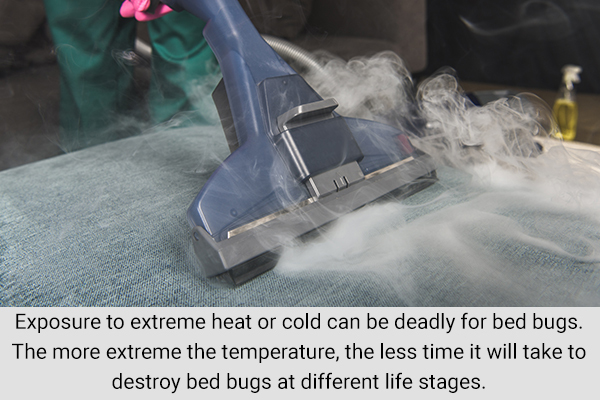In this article:
Bed bugs are tiny bloodsucking mites that dwell inside bedding, furniture, luggage, clothes, and boxes. (1) They can find their way inside your home through these contaminated items, multiply rapidly, and cause an infestation.

These pests come out from their hiding spots to feed on the blood of humans and animals every 5–10 days. This is their only source of sustenance but they can go without it for several months to up to a year.
Bed bugs mostly feed on humans while they sleep in infested beds. (2) They are drawn by the carbon dioxide, heat, and smell released from the host’s body. Once they are done feeding, they go back into hiding. (3)
It can take a lot of time and effort to get rid of a bed bug infestation, but preventive measures and early detection can save you from this ordeal. This article will give you key insights into preventing and controlling a bed bug infestation.
Ways to Prevent and Control a Bed Bug Infestation
Take these steps to steer clear of bed bugs.
1. Check for signs of a bed bug infestation
- Conduct a close visual inspection of your bed, sofa, and other furniture for bed bugs. Look for the following signs to detect the presence of bed bugs on a surface: fecal droppings, blood spots, and a sweet, musty smell.
- Install interceptors below your bed and sofa, and check them every 1–2 weeks.
- In the initial stages of infestation when there aren’t enough bed bugs to be easily detected, a homemade monitor can help you catch their activity and take proactive measures to keep them from growing. So, if you cannot find any visible sign but are still worried about a possible infestation, install this system that can alert you to the presence of even a small number of bed bugs that are otherwise undetectable through visual inspection.
- Thoroughly inspect secondhand furniture for bed bugs before bringing it home.
- Put a premium-quality cover or encasement on your mattresses and box springs to seal in any bed bugs. The cover should be transparent or light colored so that you can easily spot the bed bugs through it. It should be sturdy enough to resist tearing by the bed bugs, but make sure to check it for any holes from time to time. Lastly, it should be pretreated with pesticide to kill the bugs trapped inside it and prevent an infestation.
- When you check into a hotel, make sure to check the mattress and luggage rack in your room for bed bugs before settling in. (4)
2. Reduce clutter and vacuum the area thoroughly

- Clutter around the house provides more hiding spots for bed bugs and makes it harder to weed them out. So, it is important to remove any unwanted stuff from your living space to keep it neat, clean, and free from bed bugs. (5)
- Frequently vacuum your bedding, furniture, and floors to get rid of any bed bugs that may have come into your home. This may help eliminate adult bugs and nymphs, but not the eggs, for which you need to thoroughly wash the bedding. Once you are done vacuuming, take the machine outside to remove its bag, which needs to be carefully discarded. (6)
3. Wash your bedding regularly and use thermal treatments to dry it
- Your bedsheets and blankets need to be changed and washed regularly. Do the same for your curtains, clothes, or any fabric that comes in contact with the floor.
- People may bring their bug-infested items to be washed at a laundromat, which could contaminate the equipment there or transfer the bugs to your stuff. So, you need to be extra careful when using such shared facilities. Carry your laundry load in a plastic bag and use a new bag to transport the washed items home.
- Simply washing the contaminated items will not eliminate the bed bugs. You need to put them in a dryer set on high temperature for 30 minutes to get the job done. The heat will kill the bed bugs, after which you should directly transfer the washed items from the dryer into a clean plastic bag to be taken home. Don’t fold the washed items at the laundromat as they can end up getting contaminated again. Safely do it at home instead.
4. Use nonchemical control such as a heat/cold treatment

- Exposure to extreme heat or cold can be deadly for bed bugs. The more extreme the temperature, the less time it will take to destroy bed bugs at different life stages. This is why you must stash your clothes, bed linen, curtains, and other fabrics in a hot dryer after washing. Meanwhile, furniture, luggage, and other bug-infested items that cannot fit into the dryer should be treated with other specialized steaming, heating, or freezing equipment.
- You need to expose these larger articles and entire infestation sites (which could be a single room or the whole house) to at least 120ºF for 1½ hours to kill the eggs and prevent another generation of bugs. This cannot be achieved by increasing the indoor temperature with a thermostat or space heater. Instead, run a heat-generating device such as a steamer over your mattress, sofa, bed frames, and other nooks, edges, or spaces that may be harboring bed bugs. (7) The high heat is capable of killing the bugs almost instantly.
- Freezing the infested items at below 0ºF for at least 4 days can eliminate some infestations. (8)
- Throw away heavily infested items.
5. Use diatomaceous earth
Diatomaceous earth (DE) is a white powder-like substance that works as a natural insecticide. Sprinkle it around your home to kill bed bugs.
Bed bugs are covered by a waxy outer layer, which serves a protective function. When the bugs crawl through the powder, it will stick to this layer and slowly destroy it through sorption and abrasion, allowing the insecticide to enter the bug’s body.
DE gets jammed between the bug’s exoskeleton joints, preventing it from moving and ultimately killing it. (9)
Make sure that the DE you use is meant for insects, and follow the instructions given on the box.
How to use:
- Put on a mask to keep yourself from breathing in the toxic powder.
- Sprinkle DE over the frame of your bed and around it, on any cracks or crevices in the house walls, behind wall plates, and where the walls meet the floor.
- Apply DE on any new infestation sites detected during follow-up inspections.
It may take 1–2 weeks for DE to kill the targeted bed bugs and 2 months to completely get rid of the infestation.
Additional Tips

- Make sure your house is infested with bed bugs and not some other pest before you start the treatment.
- Don’t discard all of your infested items, but only the ones that are heavily infested and are thus unsalvageable.
- Don’t donate infested items as this will only transfer the bed bugs to other people’s homes.
- Garden or agricultural-use pesticides do not work on bed bugs. Look for the ones that are labeled “for insects.”
- Pest control products that claim to be “custom formulated” or sold by unlicensed sources are often bogus and best avoided.
- Another way to get rid of bed bugs is to starve them to death. To that end, consider going on a vacation. The bugs will have no one to feed on in an empty house.
- It is always wise to set aside your luggage after traveling, check it for bed bugs, and treat it if needed.
- Dry heat treatment to get rid of bed bugs should be conducted by a pest control professional for it to truly work.
- For heavy infestations, you may need to hire a professional. Look for one that offers integrated pest management to limit your contact with pesticides. (10)
Final Word
It is much easier to prevent a bed bug infestation than it is to get rid of it. So, it is in your best interest to take all the proactive measures to keep your home free of such pests.
If you do notice any sign of an infestation, act quickly to control it in the initial stages. The task at hand may be challenging, but it can be done. If you feel it is beyond your capabilities, hire a professional pest control service before things get worse.
- Was this article helpful?
- YES, THANKS!NOT REALLY


